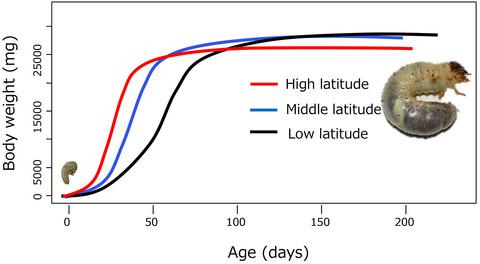当前位置:
X-MOL 学术
›
Funct. Ecol.
›
论文详情
Our official English website, www.x-mol.net, welcomes your
feedback! (Note: you will need to create a separate account there.)
Latitudinal cline of larval growth rate and its proximate mechanisms in a rhinoceros beetle
Functional Ecology ( IF 4.6 ) Pub Date : 2020-05-10 , DOI: 10.1111/1365-2435.13572 Wataru Kojima, Tatsunori Nakakura, Ayumi Fukuda, Chung‐Ping Lin, Masahiro Harada, Yuki Hashimoto, Aika Kawachi, Shiho Suhama, Ryo Yamamoto
中文翻译:

犀牛甲虫幼虫生长率的纬度及其邻近机制
更新日期:2020-05-10
Functional Ecology ( IF 4.6 ) Pub Date : 2020-05-10 , DOI: 10.1111/1365-2435.13572 Wataru Kojima, Tatsunori Nakakura, Ayumi Fukuda, Chung‐Ping Lin, Masahiro Harada, Yuki Hashimoto, Aika Kawachi, Shiho Suhama, Ryo Yamamoto

|
- Juvenile growth rate is a key life‐history trait with a major effect on various fitness components. Duration of the growing season changes with latitude, often resulting in latitudinal variations in growth rate. While many studies have shown a latitudinal cline of growth rate, most have used linear measurements of growth rate without considering the nonlinear nature of growth trajectories. Furthermore, elucidation of the proximate mechanisms causing increased growth rates would provide a fundamental understanding of the evolutionary process of the latitudinal cline of growth rates, which are largely unknown.
- We used common garden experiments to examine the latitudinal variation of growth rate. We analysed the larval growth curve of 14 populations of the univoltine Japanese rhinoceros beetle Trypoxylus dichotomus (Coleoptera: Scarabaeidae) found along a 2,000‐km latitudinal gradient. To clarify the mechanisms responsible for the latitudinal cline of growth rate, we compared food consumption and growth efficiency (i.e. the capacity to convert food into biomass) using three populations at high, middle and low latitudes.
- There was a strong positive correlation between growth rate and latitude and a strong negative correlation between age at the inflexion point of the growth curve and latitude, indicating that larvae from northern populations grew more rapidly and reached the inflexion point earlier than those from southern populations.
- The food intake increased linearly towards higher latitude. The growth efficiency of larvae from middle latitude was greater than that of larvae from low latitude, but there was no difference in the growth efficiency between high‐ and middle‐latitude populations.
- The increased growth rate at higher latitude is probably a local adaptation to complete development and growth during the short growth season. The rapid growth rate at higher latitudes could be explained by both the increased food consumption and the growth efficiency. However, the growth efficiency is probably maximized in the middle‐latitude population, suggesting that some physiological costs prevent further increase in growth efficiency at higher latitudes. This study provides compelling evidence for latitudinal cline of juvenile growth rate and disentangles the contributions of food intake and growth efficiency to the cline.
中文翻译:

犀牛甲虫幼虫生长率的纬度及其邻近机制
- 少年成长率是一项重要的生活史特征,对各种健身成分都有重要影响。生长季节的持续时间随纬度变化,通常会导致生长速度的纬度变化。尽管许多研究显示了增长率的纬度曲线,但大多数研究都使用了线性的增长率测量方法,而没有考虑增长轨迹的非线性性质。此外,阐明引起增长率上升的最接近机制将提供对增长率的纬度谱系演化过程的基本了解,而这在很大程度上是未知的。
- 我们使用常见的花园实验来检查生长速度的纬度变化。我们分析了沿2,000 km纬度梯度发现的14只单伏日本犀牛甲虫Trypoxylus dichotomus(鞘翅目:Scarabaeidae)的幼虫生长曲线。为了阐明造成纬度上升趋势的机制,我们比较了高,中,低纬度三个种群的食物消耗和生长效率(即将食物转化为生物质的能力)。
- 生长曲线与纬度的拐点处,生长速度与纬度之间呈强正相关,年龄与年龄之间呈负相关,这表明北方种群的幼虫比南部种群的幼虫生长更快,到达拐点的时间更早。
- 食物摄入量随着纬度的增加而线性增加。中纬度地区幼虫的生长效率要高于低纬度地区的幼虫,但高纬度和中纬度人群的生长效率没有差异。
- 高纬度地区增长率的提高可能是当地在短期生长季节适应了完整的生长发育。高纬度地区的快速增长可以用增加的粮食消费和增长效率来解释。但是,中纬度地区的生长效率可能最大化,这表明某些生理成本阻止了高纬度地区生长效率的进一步提高。这项研究为幼年的纬度水平提供了令人信服的证据,并弄清了食物摄入量和生长效率对青少年的贡献。











































 京公网安备 11010802027423号
京公网安备 11010802027423号